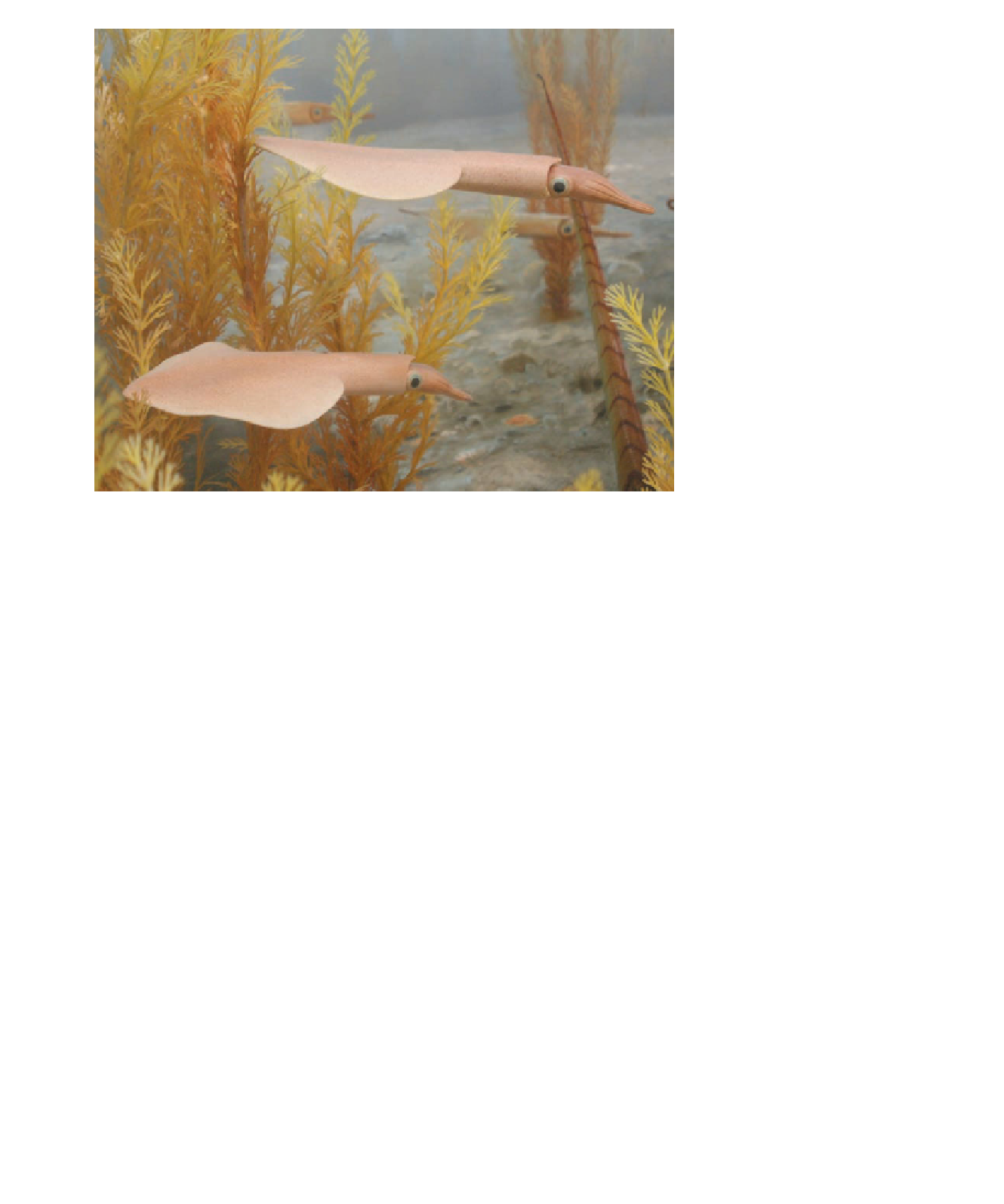Geology Reference
In-Depth Information
toward an infaunal existence
may have been an adaptive re-
sponse to increasing predation
from the rapidly evolving fi sh
and cephalopods. Bivalves,
for instance, expanded into
the infaunal niche during the
Mesozoic, and by burrowing,
they escaped predators.
The foraminifera (single-
celled consumers) diversified
rapidly during the Jurassic and
Cretaceous and continued to
be diverse and abundant to the
present. The planktonic forms
(
Figure 22.21), in particular,
diversified rapidly, but most
genera became extinct at the
end of the Cretaceous.
The primary producers in
the Mesozoic seas were vari-
ous types of microorganisms.
Coccolithophores
are an impor-
tant group of phytoplankton
(
◗
Figure 22.22a) that first
evolved during the Jurassic
and became extremely com-
mon during the Cretaceous.
Diatoms
(Figure 22.22b),
which build skeletons of
silica, made their appearance during the Cretaceous,
but they are more important as primary producers dur-
ing the Cenozoic. Diatoms are presently most abundant
in cooler oceanic waters, and some species inhabit fresh-
water lakes.
Dinofl agellates
were common during the Mesozoic
and today are the major primary producers in warm water
(Figure 22.22c).
◗
◗
Figure 22.20
Belemnoids Belemnoids are extinct squidlike cephalopods that were particularly
abundant during the Cretaceous. They are excellent guide fossils for the Jurassic and Cretaceous.
Shown here are several belemnoids swimming in a Cretaceous sea.
and despite a reduction in diversity at the end of the Cre-
taceous, remain important animals in the marine fauna to-
day. As is true now, where shallow marine waters were warm
and clear, coral reefs proliferated. An important reef builder
throughout the Mesozoic was a group of bivalves known as
rudists
. Rudists are important because they displaced cor-
als as the main reef builders during the later Mesozoic and
are good guide fossils for the Late Jurassic and
Cretaceous.
A new and familiar type of coral also ap-
peared during the Triassic, the
scleractinians.
Whether scleractinians evolved from rugose
corals or from an as yet unknown soft-bodied
ancestor with no known fossil record is still un-
resolved. In addition, another invertebrate group
that prospered during the Mesozoic was the
echinoids. Echinoids were exclusively epifaunal
during the Paleozoic, but branched out into the
infaunal habitat during the Mesozoic.
A major difference between Paleozoic and
Mesozoic marine invertebrate faunas was the
increased abundance and diversity of burrowing
organisms. With few exceptions, Paleozoic bur-
rowers were soft-bodied animals such as worms.
The bivalves and echinoids, which were epifau-
nal animals during the Paleozoic, evolved various
means of entering infaunal habitats. This trend
◗
Figure 22.21
Planktonic Foraminifera Planktonic foraminifera diversifi ed
and became abundant during the Jurassic and Cretaceous, and continued to
be diverse and abundant throughout the Cenozoic. Many planktonic forminifera
are excellent guide fossils for the Cretaceous, such as species of the genus
Globotruncana
, which is restricted to the Upper Cretaceous. Shown here are three
views of the holotype (the specimen that defi nes the species) of
Globotruncana
loeblichi
, a Late Cretaceous planktonic foraminifera.


Search WWH ::

Custom Search